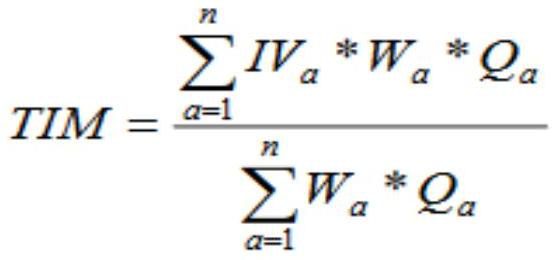Restoration method of submerged plant community in polluted fresh water
A technology of submerged plants and restoration methods, which is applied in the field of restoration of submerged plant communities in polluted freshwater waters, can solve problems such as difficulty in survival, and achieve the effects of easy survival and guaranteeing biodiversity.
- Summary
- Abstract
- Description
- Claims
- Application Information
AI Technical Summary
Problems solved by technology
Method used
Image
Examples
Embodiment 1
[0034] Example 1 Using existing methods to design a submerged phytoremediation scheme in a certain water area in Hebei
[0035] Research on existing submerged plants and underwater light fields in a certain water area in Hebei Province.
[0036] Regression analysis was performed on the water depth gradient of each monitoring point and the corresponding PAR value. The general formula of the regression equation is:
[0037] I t = I 0 e-αt (1)
[0038] In the formula, I 0 is the PAR intensity at 0m below the water surface μmol(m 2 s); t is the depth m under the water surface, I t is the PAR intensity at depth tm μmol(m 2 s), α is the light attenuation coefficient m -1 .
[0039] In the later stage, the day and night light compensation points of submerged plants and the light attenuation coefficient α of each monitoring point were substituted into the formula to obtain the submerged plant populations and the light compensation depth of the communities at each monitoring ...
Embodiment 2
[0043] Embodiment 2 restores regional submerged plants
[0044] Restore the submerged plants of certain waters in Hebei described in embodiment 1
[0045] 1. Identify dominant species for submerged plant restoration
[0046] 1.1 Layout of sampling points
[0047] The grid layout is the main point of the system layout, and at the same time, the estuary is properly intensified, and a total of 20 sampling points are arranged in this water area.
[0048] Select a cross section perpendicular to the isobath in the water body, set sampling points on the cross section as a small sample, and carry out quantitative collection with weed clips, select several sections, and infer the whole from the sample results.
[0049] According to the characteristics of the water body (size and terrain) and the distribution of aquatic plants (zoning and coverage), select several representative sections. The minimum number of sampling points must include most of the existing species of vegetation, w...
example 1
[0077] By calculating the light compensation point of the submerged plant community collocation of the same dominant species, it is found that the submerged plant community ratio has little effect on the light compensation point, for example, hornwort: asparagus: asparagus: chrysanthemum spica using 1:2 : 1 ratio, the light compensation point of the community is 28.49 μmolm -2 the s -1 , and when the ratio of hornwort: asparagus: asparagus: chrysalis: hydra verticillium is 1:2:1:1, the light compensation point of the community is 29.66 μmolm -2 the s -1 . Therefore, the commonly used ratio of 1:2:1 for engineering restoration is adopted for the basic community of P.
[0078] Among them, the proportions of pollution-resistant species, medium pollution-resistant species and sensitive species are all based on the basic project ratio of 1:2:1, and the subsequent species ratio is 1, and the species of medium pollution-resistant species and sensitive species are added in the earl...
PUM
 Login to View More
Login to View More Abstract
Description
Claims
Application Information
 Login to View More
Login to View More - R&D
- Intellectual Property
- Life Sciences
- Materials
- Tech Scout
- Unparalleled Data Quality
- Higher Quality Content
- 60% Fewer Hallucinations
Browse by: Latest US Patents, China's latest patents, Technical Efficacy Thesaurus, Application Domain, Technology Topic, Popular Technical Reports.
© 2025 PatSnap. All rights reserved.Legal|Privacy policy|Modern Slavery Act Transparency Statement|Sitemap|About US| Contact US: help@patsnap.com


